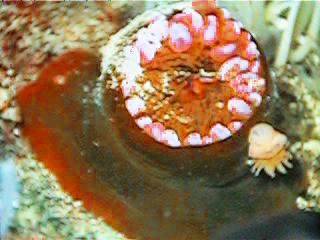 |
 |

Baceral Laceration: Fragments of tissue break off from the base and develop into new sea anemones, notably by the Plumose Anemones, Metridium senile, which is also reported to reproduce sexually. Another picture.
Sexual Reproduction: Sperm and eggs discharged into the sea. This occurs in the Pimplet Anemone, Anthopleura ballii.
 Beadlet
Anemones are the most widespread of the British sea anemones, found
the length of the British Isles on rocky shores and anywhere where there
is a hard surface to attach to. Red, green and brown varieties occur. The
best explanation of their reproduction is by parthenogenesis.
Beadlet
Anemones are the most widespread of the British sea anemones, found
the length of the British Isles on rocky shores and anywhere where there
is a hard surface to attach to. Red, green and brown varieties occur. The
best explanation of their reproduction is by parthenogenesis.
However, the author of this piece (Andy
Horton) considers the likelihood that they break off internally to
be a strong possibility. No evidence of sexual reproduction has been observed
despite extensive study.
Parthenogenesis.
The method of reproduction of the large, common and widespread sea anemone is not known.
Sea Anemones have not been kept in aquaria long enough to establish with any certainty how long sea anemones naturally live, if not predated upon or dying from causes other than old age. However, there are records of large tropical display anemones living for several decades in Public Aquaria, housing several generations of commensal Clownfish, Amphiprion ocellaris. AH
John Ottaway and Ken Sebens have made actuarial tables for anemones.Since they came up with potential lifespans on the order of several centuries, personal experience is unlikely to be a good guide. (Daphne Fautin).
Daphne G. Fautin
Professor, Biological Sciences
Curator, Natural History Museum and Biodiversity
Research Center
Haworth Hall
University of Kansas
Lawrence, Kansas 66045 USA
telephone 1-785-864-3062
fax 1-785-864-5321
for e-mail, please use
fautin@ukans.edu
lab web page: http://www.nhm.ukans.edu/~inverts
direct to sea anemone database version 2.1: biocomplexity.nhm.ukans.edu/
anemones/images/Version.html
*****************************************************************************
"Sir John Dalyell
at his time kept a well-known specimen of Actinia
equina named "Granny" in captivity for decades and at his decease
Charles Peach inherited the animal, which in this way happened to live
in Edinburgh for more than 50 years, so at least certain species seem to
be able to have a very long potential life span. Certain very deep-living
animals like bivalves are known of
being able to live for several hundred years and I guess it is likely that
certain deep-living sea anemones also could reach such ages."
(from
Hans.G.Hansson@TMBL.GU.SE
**** Tjaernoe Marine Biological Lab. ****
http://www.tmbl.gu.se
Phone: +46 526 686 36 Fax: +46 526 686 07
Personal home page: http://www.tmbl.gu.se/staff/HansGHanssonP.html
)
*****************************************************************************
I have kept a specimen of the "strawberry" Beadlet
Actinia
fragacea from the NE Atlantic Ocean that lived for 10 years (without
showing any sign of reproducing) and it may have lived much longer. I got
the specimens muddled up when transferring them to another tank. AH
*****************************************************************************
"It is said that they are essentially immortal,
showing no obvious senescence either at the individual or the cellular
levels, and certainly not at the clone level in clonal species (but of
course they do die from other causes, e.g. predation and disease).
A couple anecdotal examples:
Bob Paine has been watching the same Urticina crassicornis at Tatoosh Island since 1968, and it has not moved nor changed in size.
There is the story of the legendary anemone kept in Edinburgh, I think, for something like 90 years; the anemone died of a seawater system malfunction, not old age. This is reported in Ricketts and Calvin among other places.
I know that John Pearse has kept Anthopleura artemesia in captivity for well over 10 years and they're doing just fine.
Ken Sebens calculated from population-level data (observed field mortality rates) that the average age of Anthopleura xanthogrammica on the Washington coast must be around 500 years with some individuals, theoretically anyway, having been around since the Pleistocene (this is heresay from Bob Paine based on Ken's calculations).
Hope these help! I would very much appreciate hearing about any other responses you receive." Good luck! Dave
DAVID L. SECORD, PhD
Assistant Professor of Biology & Environmental
Science Coordinator (UWT)
and Adjunct Assistant Professor of Zoology (UW
Seattle)
University of Washington, Tacoma TEL: 253-692-5659
Interdisciplinary Arts & Sciences FAX:
253-692-5612
1900 Commerce Street (MS 358436) TDD: 253-692-4413
Tacoma, WA 98402-3100 USA EMAIL:
dave@u.washington.edu
GALAPAGOS 2000 TRIP INFORMATION AND APPLICATION:
http://www.tacoma.washington.edu/liberal/study-abroad/galapagos.html
*****************************************************************************
LIFE SPANS
Among single-celled organisms, which reproduce by cell division, the concept of an individual life span loses some validity, as in a sense the individual continues to exist indefinitely. Thus arbitrary definitions of individual lives, such as the period between reproductive divisions, may be used to estimate life span, but such estimates are not comparable to those for sexually reproducing organisms.
In most species the maximum life span can be estimated from the longest
observed survival of individual members of the
species. The maximum human life span is reported to be between 115
and 150 years. In many animals, the maximum life span
has been calculated from survival in captivity, where safety from predators
allows many individuals to live to an advanced old
age seldom reached in the wild.
Extract from Encyclopaedia Britannica (Life Spans)
Anemones are multi-celled organisms, but in some
respects (reproduction) may resemble unicellular organisms. However, even
sea anemones not observed to reproduce sexually could do so on occasions.
AH
Cnidaria
Web Site (World)
British Sea Anemones DataBase Home
BMLSS Home Page
Cnidaria Home
|
|
|
News 2018 |
Membership Form |
|